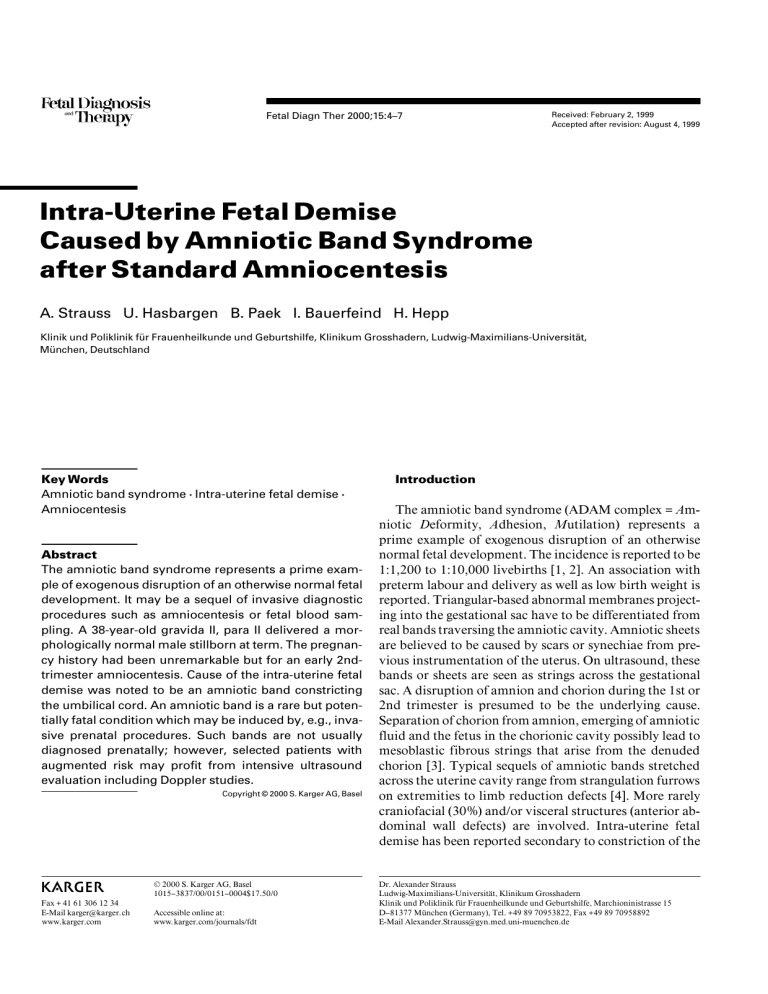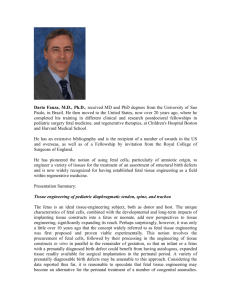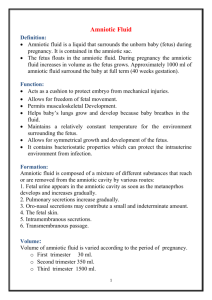Intra-Uterine Fetal Demise Caused by Amniotic Band Syndrome

Fetal Diagn Ther 2000;15:4–7 Received: February 2, 1999
Accepted after revision: August 4, 1999
Intra-Uterine Fetal Demise
Caused by Amniotic Band Syndrome after Standard Amniocentesis
A. Strauss U. Hasbargen B. Paek I. Bauerfeind H. Hepp
Klinik und Poliklinik für Frauenheilkunde und Geburtshilfe, Klinikum Grosshadern, Ludwig-Maximilians-Universität,
München, Deutschland
Key Words
Amniotic band syndrome
W
Intra-uterine fetal demise
W
Amniocentesis
Introduction
Abstract
The amniotic band syndrome represents a prime example of exogenous disruption of an otherwise normal fetal development. It may be a sequel of invasive diagnostic procedures such as amniocentesis or fetal blood sampling. A 38-year-old gravida II, para II delivered a morphologically normal male stillborn at term. The pregnancy history had been unremarkable but for an early 2ndtrimester amniocentesis. Cause of the intra-uterine fetal demise was noted to be an amniotic band constricting the umbilical cord. An amniotic band is a rare but potentially fatal condition which may be induced by, e.g., invasive prenatal procedures. Such bands are not usually diagnosed prenatally; however, selected patients with augmented risk may profit from intensive ultrasound evaluation including Doppler studies.
Copyright © 2000 S. Karger AG, Basel
The amniotic band syndrome (ADAM complex = Amniotic Deformity, Adhesion, Mutilation) represents a prime example of exogenous disruption of an otherwise normal fetal development. The incidence is reported to be
1:1,200 to 1:10,000 livebirths [1, 2]. An association with preterm labour and delivery as well as low birth weight is reported. Triangular-based abnormal membranes projecting into the gestational sac have to be differentiated from real bands traversing the amniotic cavity. Amniotic sheets are believed to be caused by scars or synechiae from previous instrumentation of the uterus. On ultrasound, these bands or sheets are seen as strings across the gestational sac. A disruption of amnion and chorion during the 1st or
2nd trimester is presumed to be the underlying cause.
Separation of chorion from amnion, emerging of amniotic fluid and the fetus in the chorionic cavity possibly lead to mesoblastic fibrous strings that arise from the denuded chorion [3]. Typical sequels of amniotic bands stretched across the uterine cavity range from strangulation furrows on extremities to limb reduction defects [4]. More rarely craniofacial (30%) and/or visceral structures (anterior abdominal wall defects) are involved. Intra-uterine fetal demise has been reported secondary to constriction of the
ABC
Fax + 41 61 306 12 34
E-Mail karger@karger.ch
www.karger.com
© 2000 S. Karger AG, Basel
1015–3837/00/0151–0004$17.50/0
Accessible online at: www.karger.com/journals/fdt
Dr. Alexander Strauss
Ludwig-Maximilians-Universität, Klinikum Grosshadern
Klinik und Poliklinik für Frauenheilkunde und Geburtshilfe, Marchioninistrasse 15
D–81377 München (Germany), Tel. +49 89 70953822, Fax +49 89 70958892
E-Mail Alexander.Strauss@gyn.med.uni-muenchen.de
Fig. 1. Constriction of the umbilical cord by an amniotic band.
umbilical cord by amniotic bands [5, 6]. In 1685amniotic bands were first described by Portal [7] in Paris, France.
Burdach reported strangulation of the umbilical cord by amniotic bands in 1758. Since then 50 analogous cases have been published in the world literature [8].
Constriction of the umbilical cord in the context of a
1st- or 2nd-trimester invasive procedure is extremely rare.
A case report of this sudden, hardly predictable and fatal complication, causing intra-uterine fetal demise at term, is presented.
Autopsy
A twofold constriction of the umbilical cord near to the fetal origin by an amniotic band without adhesions accompanied by a fresh focal umbilical haemorrhage was present. Strangulation of the cord caused a diminishment of the calibre from 16 to 6 mm. A triangular amniotic sheet (basis length 15 cm) marked the placental insertion.
The examination of the placenta did not show any structural defects
(650 g, 18 ! 18 ! 3 cm). Histological differentiation was appropriate to gestational age. Amniotic membranes appeared to be smooth and shiny. A central insertion of the umbilical cord (length
68 cm) with three blood vessels was present. No further fetal anomalies could be detected.
Case Report
A 38-year-old gravida II, para II presented at term with complete loss of fetal movements. Intra-uterine fetal demise of a morphologically normal fetus was diagnosed by ultrasound. There was no ultrasonographic suspicion of an amniotic band or sheet. Induction of labour was accomplished with prostaglandins. The patient subsequently delivered a male stillborn (3,430 g, 57 cm). After delivery, an amniotic band constricting the umbilical cord and causing marked stenosis near the fetal origin was noted (fig. 1).
During the early 2nd trimester (14 weeks of gestation), an uncomplicated transabdominal amniocentesis (continuous ultrasound guidance, paraplacental puncture, 20-gauge needle) had been performed because of advanced maternal age. Karyotype analysis revealed a normal male 46,XY. Amniotic fluid leakage did not occur. Subsequent ultrasound scans every 4 weeks confirmed an undisturbed fetal development, a normal amount of amniotic fluid and adequate fetal movements. Pregnancy history had otherwise been unremarkable
(fig. 2).
Diagnosis
Intra-uterine fetal demise secondary to torsion and strangulation of the umbilical cord by an amniotic band. The only remarkable feature through the whole pregnancy had been an early 2nd-trimester standard amniocentesis.
Discussion
Constriction of the umbilical cord by an amniotic band is a rare in utero complication, associated with a high rate of fetal mortality and congenital anomalies. The risks of preterm delivery ( !
37 weeks of gestation) and low birth weight ( !
2,500 g) are reported to be increased 4.3 and 9.3
times, respectively, as compared with controls [9]. Malformations in general appear to result from four mechanisms: interruption of normal morphogenesis (cleft lip/ palate, renal agenesis, omphalocele, anal atresia), malformation caused by fetal vascular compromise (gastro-
Fetal Demise due to Amniotic Band
Syndrome
Fetal Diagn Ther 2000;15:4–7 5
Fig. 2. Cardiotocography 2 days before intra-uterine fetal demise due to umbilical cord constriction by an amniotic band.
schisis, gallbladder agenesis, single umbilical artery), deformation due to intra-uterine compression (abnormal facies, clubbed feet and hands) and disruption of normally developed structures (lateral encephalocele, constricting rings, limb amputation, facial clefts at nonamniotic sites) [10]. Amniotic band syndrome is a controversial disease [11]. Not its consequences but rather its aetiology and natural course are unknown. Several hypotheses are discussed in the literature. Torpin (1965) proposed the cause to be an early isolated rupture of the amnion which then separates from the chorion and leaves the fetus in the extra-amniotic space of the chorionic cavity. The initially fibrous amniotic bands are supposedly composed of mesodermal amniotic surface and exposed chorionic surface
[3]. However, this mechanistic perspective does not explain the association with damage to internal organs and other severe fetal anomalies. Other theories propose a local congenital defect in the production of Wharton’s jelly that creates a weak point in the umbilical cord [12, 13].
In 1930, Streeter [14] suggested the primary defect to be located in the embryonic germinal disc. Accordingly, the amniotic band is a product and not the cause of fetal anomalies. This may explain why constriction rings and amputations are usually transverse and not diagonal [15].
On the other hand, a teratogenic event is under discussion because amniotic bands occur far more frequently in monozygotic than in dizygotic twins [10]. Another explanation presumes multifactorial or polygenic inheritance
[16]. The association of invasive prenatal procedures and amniotic band syndrome is described by several authors.
Possible causes of the postulated amniotic rupture (Torpin) are amniocentesis and fetal blood sampling. Kino [17] and Poswillo [18] have demonstrated in animal models that strangulation furrows, limb reduction defects and cleft lip or palate can be late sequels of invasive prenatal procedures. On the other hand, Jackson et al. [19] and Smidt-
Jensen et al. [20] could not demonstrate an increased risk after amniocentesis in humans. Nevertheless, strangulation with torsion of the umbilical vessels by an amniotic band may be a rare fatal complication of a routine prenatal karyotyping. We question whether it should be included in the risk assessment of intra-uterine needle procedures. To determine the exact relation between amniotic bands and sampling manoeuvres, further studies are required.
To date this severe complication of umbilical cord strangulation by amniotic bands is not usually diagnosed prenatally by ultrasound. Systematic inspection of the umbilical cord in every level II ultrasound scan does not seem reasonable or feasible, given the rarity of the condition and the low probability of detection [21]. Incorporating new techniques, such as Doppler colour flow mapping and measurements of vascular resistances, may prove helpful in selected patients with augmented risk (unexplained decrease or absence of fetal movements) [22].
Once the diagnosis is made, frequent monitoring for the evidence of fetal distress is required. Preterm delivery may be indicated, if any signs of compromise are demonstrated.
6 Fetal Diagn Ther 2000;15:4–7 Strauss/Hasbargen/Paek/Bauerfeind/Hepp
References
1 Baker CJ, Rudolph AJ: Congenital ring constrictions and intrauterine amputation. Am J
Dis Child 1971;212:393.
2 Eriksen L, Kringelbach M, Sundberg K: Intrapartum death due to an amniotic band. Br J
Obstet Gynaecol 1996;103:388–390.
3 Torpin R: Amniochorionic mesoblastic fibrous strings and amniotic bands. Am J Obstet Gynecol 1965:91:65.
4 Quintero RA, Morales WJ, Phillips J, Kalter
CS, Angel JL: In utero lysis of amniotic bands.
Ultrasound Obstet Gynecol 1997;10:316–320.
5 Cody ML, Uetzmann IF: Amniotic bands as a cause of intrauterine fetal death. Am J Obstet
Gynecol 1957;74:1102
6 Kotz HL, Vidone RA: Intrauterine fetal death due to amniotic bands. Obstet Gynecol 1959;
13:717.
7 Portal P: La pratique des accouchements. Paris
1685.
8 Hallak M, Pryde PG, Qureshi F, Johnson MP,
Jacques SM, Evans MI: Constriction of the umbilical cord leading to fetal death: A report of three cases. J Reprod Med 1994;39:561–
565.
9 Wheben H, Fleisher J, Karimi A, Mathony A,
Ninkoff H: The relationship between the ultrasonographic diagnosis of innocent amniotic band, development and pregnancy outcomes.
Obstet Gynecol 1993;81:565–568.
10 Lockwood C, Ghidini A, Romero R: Amniotic band syndrome in monozygotic twins: Prenatal diagnosis and pathogenesis. Obstet Gynecol
1988;71:1012–1016.
11 Evans MI: Amniotic bands. Ultrasound Obstet
Gynecol 1997;10:307–308.
12 Virgilio LA, Spangler DB: Fetal death secondary to constriction and torsion of the umbilical cord. Int J Gynaecol Obstet 1978;102:32.
13 Weber J: Constriction of the umbilical cord as a cause of foetal death. Acta Obstet Gynecol
Scand 1963;42:259.
14 Streeter GL: Focal deficiencies in fetal tissues and their relation to intrauterine amputation.
Contrib Embryol 1930;22:1.
15 Bronshtein M, Zimmer EZ: Do amniotic bands amputate fetal organs? Ultrasound Obstet Gynecol 1997;10:309–311.
16 Tadmor OP, Kreisberg GA, Achiron R, Parat
S, Yagel S: Limb amputation in amniotic band syndrome: Serial ultrasonographic and Doppler observations. Ultrasound Obstet Gynecol
1997;10:312–315.
17 Kino Y: Clinical and experimental studies of the congenital constriction band syndrome, with an emphasis on its etiology. J Bone Joint
Surg 1975;57:636.
18 Poswillo D: Observation of fetal posture and causal mechanisms of congenital deformity of palate, mandible and limbs. J Dent Res 1966;
45:584.
19 Jackson LG, Zachary JM, Fowler SE: A randomised comparison of transcervical and transabdominal chorion villus sampling. N
Engl Med J 1992;327:594–598.
20 Smidt-Jensen SL, Permin M, Phillip J: Randomized comparison of transabdominal, transcervical chorionic villi sampling and amniocentesis (in Danish). Ugeskr Læger 1993;155:
1446–1456.
21 Grillo M, Weisner K, Semm K: Sonographic diagnosis of the amniotic band syndrome. Geburtshilfe Frauenheilkd 1989;49:1093–1095.
22 Kanayama MD, Gaffey TA, Ogburn PL: Constriction of the umbilical cord by an amniotic band, with fetal compromise illustrated by reverse diastolic flow in the umbilical artery. J
Reprod Med 1995;40:71–73.
Fetal Demise due to Amniotic Band
Syndrome
Fetal Diagn Ther 2000;15:4–7 7





